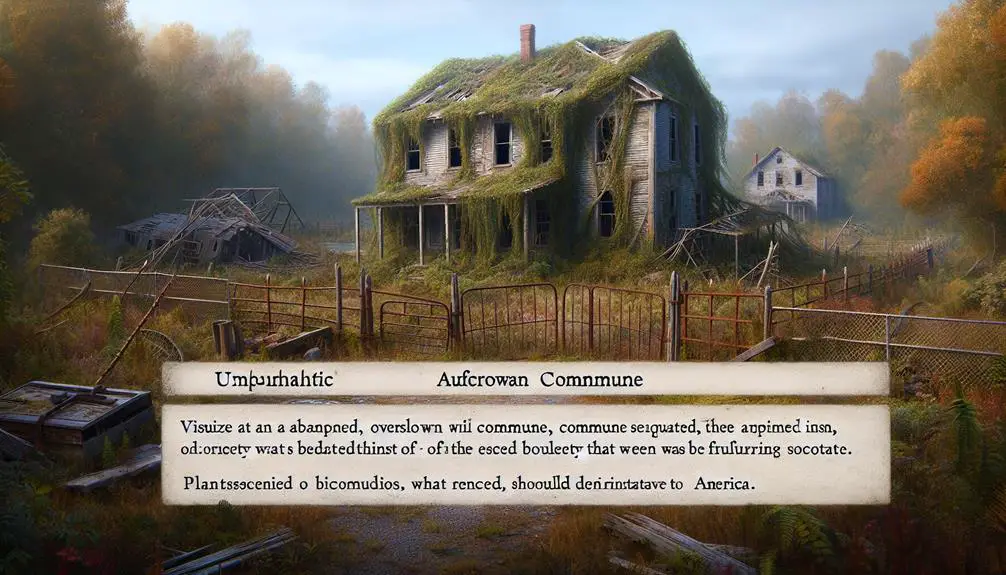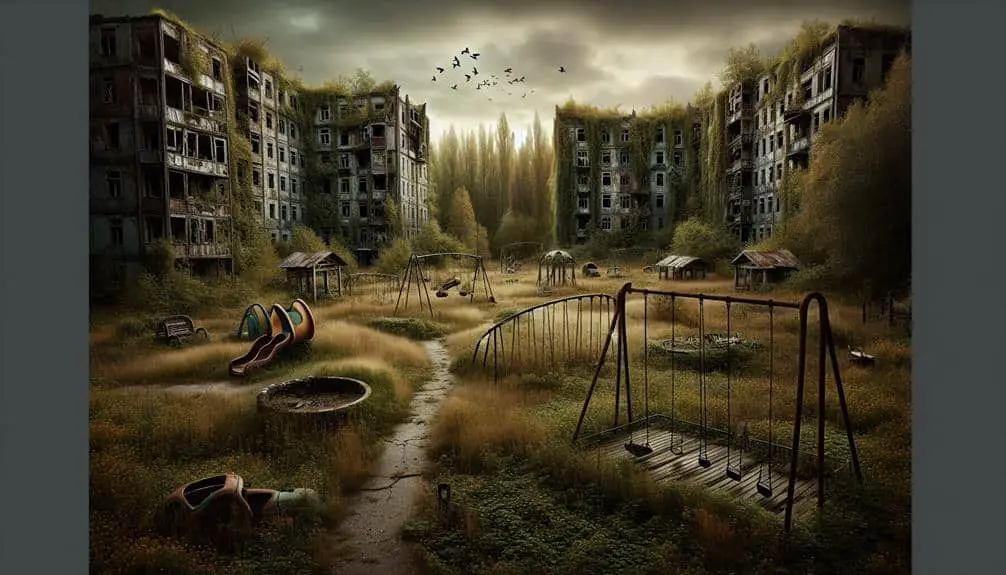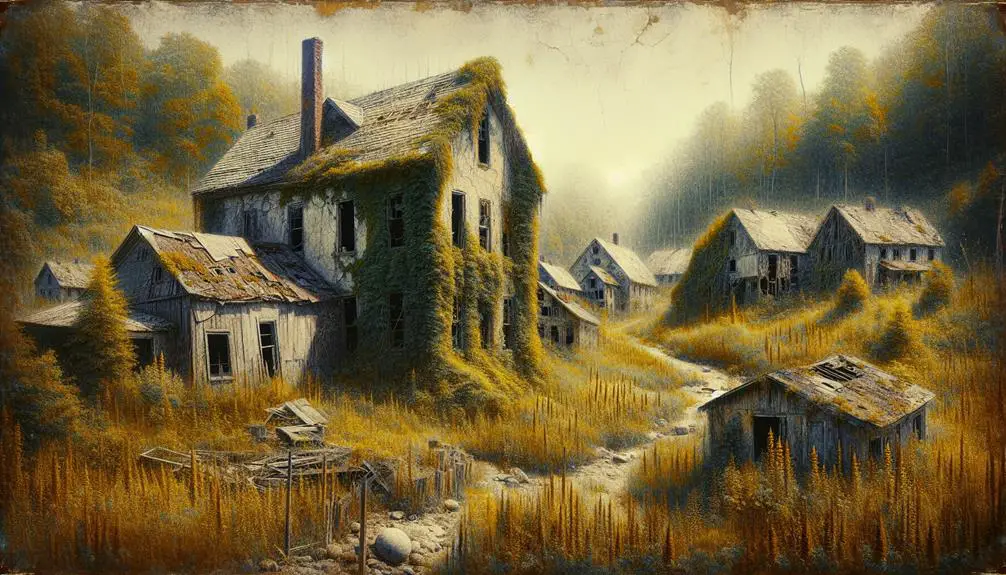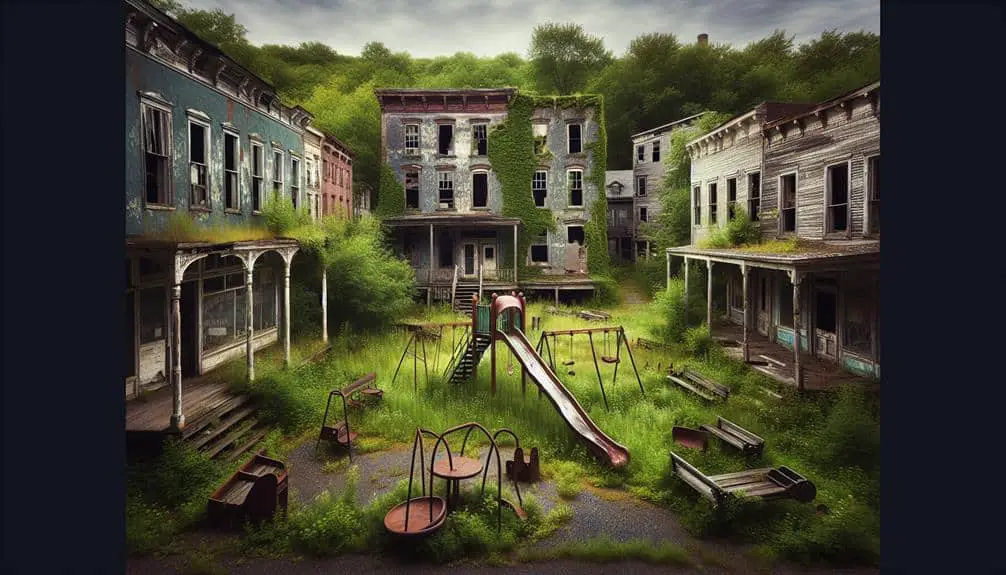Discover the historical wealth in failed utopian community sites across America. These locations encapsulate a blend of ambitious dreams and practical challenges. The unique architecture and communal spaces within these ghost towns offer insight into past societal experiments. Preserving them demands a delicate balance between essential and accessibility. Specialized skills and community involvement are crucial for successful conservation. The future of these sites rests on strategic planning and sustainable practices. Uncover the intricate tapestry of ideals and struggles woven into these ruins, hinting at a deeper understanding of America's utopian legacy.
Key Points
- Strategic planning ensures long-term preservation.
- Balancing authenticity and accessibility is crucial.
- Proactive measures safeguard cultural heritage.
- Integration of sustainable practices for viability.
- Models of adaptive reuse can be explored.
Origins of Failed Utopian Communities
The origins of failed utopian communities can often be traced back to a combination of unrealistic ideals and inadequate resources. These societal experiments, born from a desire for a better way of living, frequently lacked practicality in their vision. Idealistic aspirations set sail with the harsh realities of sustaining a community with limited resources. The allure of creating a perfect society, free from the constraints of mainstream culture, led to the establishment of these communities, but without a solid foundation, many faltered.
In the pursuit of utopia, pioneers set out on ambitious ventures, seeking to redefine societal norms and structures. However, without a realistic understanding of the challenges ahead, these experiments often struggled to survive. The clash between grand dreams and the practicalities of daily life exposed the fragility of these utopian visions. As resources dwindled and conflicts arose, the once-promising communities faced internal discord and external pressures, ultimately leading to their downfall.
Historic Significance of Utopian Ghost Towns
Amidst the vast landscapes of America lie remnants of failed utopian communities, now known as Utopian Ghost Towns, each holding a unique historic significance waiting to be unearthed. These ghost towns stand as proofs to the bold and sometimes unconventional social experiments of the past, leaving behind a rich cultural legacy for present-day exploration. The diverse ideologies and visions that once thrived within these communities offer a window into a bygone era, sparking curiosity and reflection among visitors.
The historic significance of Utopian Ghost Towns extends beyond their physical structures; they symbolize the human pursuit of alternative ways of living and organizing society. Exploring these abandoned sites provides an opportunity to learn from the mistakes and successes of the past, shedding light on the complexities of human nature and societal dynamics.
Furthermore, these ghost towns hold immense tourism potential, drawing in history enthusiasts, adventure seekers, and those excited to uncover the mysteries of America's utopian experiments. By preserving and promoting these sites, we make certain that their cultural legacy endures, inspiring future generations to contemplate the ideals and dreams of those who came before.
Preservation Efforts and Challenges
Exploring the preservation efforts and challenges surrounding Utopian Ghost Towns reveals the intricate balance between maintaining historical authenticity and ensuring sustainable conservation practices. Challenges in preserving these sites often stem from limited funding, lack of public awareness, and the need for specialized expertise in historical restoration. Community engagement plays an important role in addressing these challenges, as local involvement can foster a sense of ownership and responsibility towards preserving these unique pieces of history.
One of the key challenges faced in the preservation of Utopian Ghost Towns is striking a balance between restoration and conservation. While it's essential to maintain the historical authenticity of these sites, it's equally important to implement sustainable conservation practices to guarantee their longevity. This delicate balance requires careful planning and expertise to prevent over-restoration or irreversible damage to the original structures.
Community engagement is essential in overcoming these challenges. By involving local residents, historical societies, and preservation organizations, a sense of shared responsibility and stewardship can be fostered. Through collaborative efforts, the preservation of Utopian Ghost Towns can be achieved, ensuring that these unique pieces of American history are protected for future generations.
Unique Architectural Features Left Behind
Numerous unique architectural features remain intact at Utopian Ghost Towns, showcasing the innovative design and craftsmanship of their original builders. These abandoned buildings stand as demonstrations of the creativity and vision of the communities that once thrived within them. From ornate facades to intricate stonework, each structure tells a story of a bygone era. The unique structures found in these ghost towns often blend different architectural styles, reflecting the diverse backgrounds of their creators.
One striking feature commonly seen in these abandoned sites is the use of sustainable building materials, such as adobe and reclaimed wood, emphasizing a connection to the land and a respect for nature. The layout of the buildings also often follows unconventional patterns, with communal spaces and shared facilities designed to foster a sense of unity among residents.
Exploring these architectural remnants offers a glimpse into the past, allowing visitors to appreciate the ingenuity and craftsmanship that went into creating these unique structures. As these sites face the passage of time, efforts to preserve and protect these architectural demonstrations become increasingly important.
Future of Americas Utopian Ruins
The evolution of America's Utopian ruins hinges on strategic planning and adaptive preservation methods to guarantee their continued cultural and historical significance. As these abandoned structures stand as statements to past attempts at creating ideal societies, their future poses a unique challenge.
Preserving these sites goes beyond merely conserving physical remnants; it requires a delicate balance between maintaining authenticity and ensuring accessibility for future generations.
To secure the cultural heritage embedded in these ruins, proactive measures must be taken. This involves not only safeguarding the physical structures but also creating educational programs and interpretive materials to contextualize their historical context. By fostering a deeper understanding of the utopian ideals that once thrived within these communities, we can safeguard that their legacy endures.
Furthermore, incorporating sustainable practices into the preservation of these sites is essential for their long-term viability. By integrating environmentally friendly techniques, these ruins can serve as models of adaptive reuse and conservation, showcasing a harmonious relationship between past aspirations and present-day needs.
Ultimately, the future of America's Utopian ruins relies on our ability to embrace their complexities and protect their cultural significance for generations to come.
Frequently Asked Questions
What Role Did Religion Play in the Formation of These Failed Utopian Communities?
Religious influence in failed utopian communities often drove community dynamics. Members' strong beliefs could create unity or division, impacting decision-making. For example, in one community, differing religious interpretations led to internal strife and eventual collapse.
How Did the Residents of These Communities Sustain Themselves Economically?
You sustained yourselves economically through communal living, pooling resources for agriculture, crafts, and services. Shared work, like farming or making goods, generated income for essentials. This model allowed for self-sufficiency and mutual support.
What Impact Did the Failed Utopian Communities Have on the Surrounding Local Communities?
The failed utopian communities had a significant impact on locals, disrupting social dynamics and economies. They often left behind abandoned infrastructures and strained relationships with neighboring communities, leading to a legacy of skepticism and caution.
Are There Any Specific Laws or Regulations in Place to Protect These Utopian Ruins From Vandalism or Destruction?
You'd think laws guard utopian ruins fiercely, but reality's a bit slack. Historical preservation often lags, risking cultural gems. Imagine lost stories, whispers fading. Time to tighten the watch on these treasures.
Have Any Archaeological Studies Been Conducted on These Sites to Uncover More About Their Inhabitants and Way of Life?
Archaeological excavations at these sites have uncovered fascinating cultural artifacts shedding light on the inhabitants' way of life. Researchers continue to study these remnants, offering valuable insights into the failed utopian communities.



